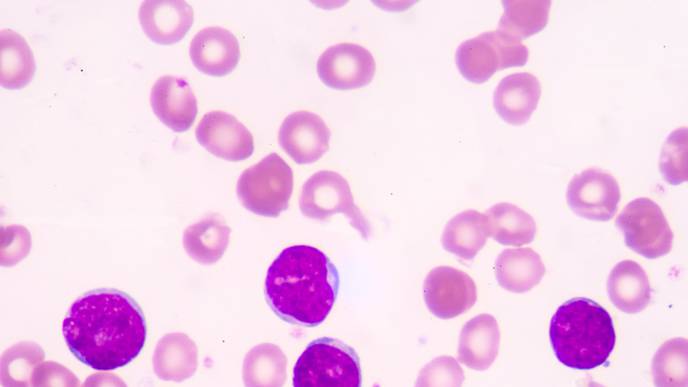ReachMD
Be part of the knowledge.™Poverty Linked to Higher Relapse Risk of Acute Lymphoblastic Leukemia

Newswise — (WASHINGTON, DC, April 18, 2023) –
Kids diagnosed with acute lymphoblastic leukemia (ALL) who reside in severe poverty and were receiving maintenance therapy encountered almost twice the likelihood of relapse as those who did not face poverty, as stated in a study released in the present edition of Blood. Additionally, a larger percentage of these kids struggled with adhering to treatment, although the correlation between poverty and relapse risk can only be partially accounted for by this factor, according to the researchers.
According to Aman Wadhwa, MD, MSPH, the lead author of the study and a pediatric oncologist and health sciences researcher in the Division of Pediatric Hematology/Oncology at the University of Alabama at Birmingham, "Although ALL is a treatable ailment and there were relatively few relapses overall, children living in extreme poverty - those whose families were genuinely struggling and unable to make ends meet - had a substantially higher risk of relapse, even after accounting for all other biological and prognostic variables."
He further added, "Furthermore, these children faced greater difficulty in maintaining the necessary level of treatment adherence during maintenance therapy, which is crucial for sustained remission. These results highlight the critical importance of identifying patients experiencing such financial hardships and providing them with any available resources to assist them."
To elaborate on the available resources that could help, for instance, in case of transportation issues, providing gas cards or ride shares could make a significant difference. Additionally, offering easy-to-understand education on the significance of adhering to maintenance therapy may also be beneficial.
ALL is the most prevalent childhood cancer that affects the blood and bone marrow. Approximately 60% of ALL cases are diagnosed in children, and with the advancements in treatment, the five-year survival rates now approach 90%. However, this is not uniform or equitable for all children, as stated by Dr. Wadhwa.
Dr. Wadhwa mentioned that this study is the first of its kind to examine the impact of poverty at the individual level, measured by annual household income, on relapse rates in children with ALL. Prior studies have relied on community-level poverty indicators such as zip codes, which can have significant variations in socioeconomic status, or health insurance status.
This study was a secondary analysis of the Children's Oncology Group Study, which examined the adherence to oral 6-mercaptopurine during maintenance therapy for ALL, and it included 592 patients. These patients were enrolled between 2006 and 2012 and followed up for a median of 7.9 years. Two-thirds of the patients were male, and the median age at diagnosis and enrollment was 5 and 6 years, respectively. The most frequently reported race/ethnicity was Hispanic (35%), followed by non-Hispanic white (32.4%), Black (18.2%), and Asian (14.4%). Overall, 34.8% of parents reported their education level as high school or lower. During the study's commencement, researchers collected self-reported individual income information, and they used data from the U.S. Census Bureau to classify patients living above or below the federal poverty threshold. Among those living in poverty, patients were considered to be living in extreme poverty if their household income was over 120% of the yearly federal poverty threshold.
More than 12% of the children who participated in the study were living in extreme poverty, and they were more likely to report being Hispanic or Black and having a larger household size (an average of six people compared to four for those not living in extreme poverty). There were no notable differences in disease or treatment intensity by poverty status. Three years after enrollment, the rate of relapse among children living in extreme poverty was almost double that of those living above the poverty threshold, at 14.3% compared to 7.6%. Furthermore, children living in extreme poverty were significantly more likely to be non-adherent to prescribed treatment compared to those not living in extreme poverty, with a rate of 57.1% versus 40.9%.
Extreme poverty, like other social determinants of health, was on par with some clinical measures used to risk stratify patients, Dr. Wadhwa explained.
Dr. Wadhwa stated that when he sees a patient with a new diagnosis of ALL, he looks at the biological factors to determine if they have standard or high-risk disease. Patients with high-risk disease are 2.5 times more likely to relapse, which is similar to the risk of relapse that is observed with extreme poverty and other social determinants of health.
The findings underscore the need for interventions that assess and develop tailored solutions to make sure patients have equitable access to care.
Dr. Wadhwa emphasized the need to design interventions and treat social factors that increase the risk of relapse in patients with ALL. He suggested that if patients are risk stratified and given different treatments based on certain biological factors, then similar attention should be given to social factors. He added that while intensifying therapy may lead to some gains, if the patient is unable to receive the treatment, it is of no use.
Currently, poverty and other barriers to optimal care are not typically assessed or considered as part of treatment planning for patients with ALL. However, given the findings of this study, it may be necessary to routinely assess and address these factors in order to improve outcomes for certain populations.
Although this study has a small sample size and was conducted before measurable residual disease became a routine part of clinical care, its findings provide a basis for future research to explore other social determinants of health and their potential influence on childhood cancers. Furthermore, the study's results can guide the development of interventions to tackle these obstacles.
# # #
Blood (www.bloodjournal.org), the most cited peer-reviewed publication in the field of hematology, is available weekly in print and online. Blood is a journal of the American Society of Hematology (ASH) (www.hematology.org).
Facebook Comments